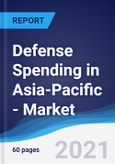Key Highlights
- Defense spending covers capital items, military personnel, government defense agencies, and related expenditure on defense and peacekeeping. The value of the market is taken to include both current and capital expenditure on the armed forces, including funding contributions to peacekeeping forces, such as the United Nations Peacekeeping Forces, defense ministries and other government agencies engaged in defense projects, paramilitary forces (when judged to be trained and equipped for military operations) and military space activities. Expenditure on personnel (including salaries and social services of both military and civil personnel, and retirement pensions of military personnel), procurement, research and development, infrastructure spending, military aid (taken as expenditure by the donor country) and general operations and maintenance are also included. Note that current expenditure on previous military activity such as veterans' benefits, weapon destruction, demobilization, and defense conversion are all excluded, as is expenditure on civil defense.
- The Asia-Pacific defense spending market had total budget allocation of $497.8bn in 2020, representing a compound annual growth rate (CAGR) of 4.8% between 2016 and 2020.
- Market consumption volumes declined with a compound annual rate of change (CARC) of -1.1% between 2016 and 2020, to reach a total of 7.2 million active serving personnel in 2020.
- Economic growth has facilitated spending on defense, which has been further driven by geopolitical instability in the region.
Scope
- Save time carrying out entry-level research by identifying the size, growth, major segments, and leading players in the defense spending market in Asia-Pacific
- Use the Five Forces analysis to determine the competitive intensity and therefore attractiveness of the defense spending market in Asia-Pacific
- Leading company profiles reveal details of key defense spending market players’ global operations and financial performance
- Add weight to presentations and pitches by understanding the future growth prospects of the Asia-Pacific defense spending market with five year forecasts
Reasons to Buy
- What was the size of the Asia-Pacific defense spending market by value in 2020?
- What will be the size of the Asia-Pacific defense spending market in 2025?
- What factors are affecting the strength of competition in the Asia-Pacific defense spending market?
- How has the market performed over the last five years?
- What are the main segments that make up Asia-Pacific's defense spending market?
Table of Contents
Companies Mentioned (Partial List)
A selection of companies mentioned in this report includes, but is not limited to:
- AviChina Industry & Technology Co., Ltd.
- Hindustan Aeronautics Ltd
- BAE Systems Inc
- Kawasaki Heavy Industries, Ltd.
- Mitsubishi Heavy Industries, Ltd.
- The Boeing Company
Table Information
| Report Attribute | Details |
|---|---|
| No. of Pages | 60 |
| Published | September 2021 |
| Forecast Period | 2020 - 2025 |
| Estimated Market Value ( USD | $ 497.76 Billion |
| Forecasted Market Value ( USD | $ 676.18 Billion |
| Compound Annual Growth Rate | 6.3% |
| Regions Covered | Asia Pacific |









